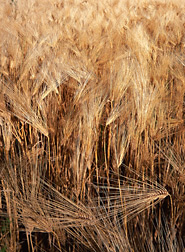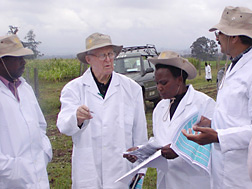Collectively Facing an Ugly Rust
When the threat to a food staple like wheat is worldwide, the best way to counter it is to enlist the world’s experts in a research coalition. That’s just what has been done to answer the very real threat of Ug99, a new stem rust to which most of the wheat and barley grown in the United States and the rest of the world has no resistance.
As part of that global response, the Agricultural Research Service became a founding partner in the Borlaug Global Rust Initiative (BGRI), in alliance with the International Maize and Wheat Improvement Center (CIMMYT), the International Center for Agricultural Research in the Dry Areas (ICARDA), the Food and Agriculture Organization of the United Nations, and Cornell University. The BGRI is chaired by Nobel Peace Prize winner Norman E. Borlaug.
“To reduce the vulnerability of U.S. and global wheat crops to Ug99 requires an international partnership of scientists and institutions with diverse expertise and facilities. We are fortunate that ARS was one of the first institutions to respond to the call from Dr. Borlaug,” says Ravi Singh, BGRI’s chief wheat scientist.
“ARS has several of the world’s small pool of experts in cereal rust research,” explains Kay Simmons, ARS national program leader for plant genetics and grain crops. “We have several collaborative research projects under way that are feeding critical information into BGRI, and these partnerships are the best way to leverage everybody’s resources to combat Ug99.”
ARS is partnering with CIMMYT and the Kenya Agricultural Research Institute (KARI), to screen wheat and barley lines from breeders from all over the United States for Ug99 resistance.
Kenya has had Ug99 since 2001, so having use of the nursery there provides a way for U.S. breeders to find out which of their new varieties and lines may be able to stand up to the rust without bringing the pathogen into the United States and without each wheat- or barley-breeding project trying to start its own nursery overseas.
More than 5,000 U.S. lines have been evaluated through this program so far.
“Everybody wins. Not only does the United States benefit from this nursery, but ARS is also sharing all the information from these screenings with the other members of BGRI, and they are sharing their results with us,” Simmons says.
In fact, researchers from other BRGI members—such as Agriculture and Agri-Food Canada, KARI, and CIMMYT—help score the wheats at various points in the growing season alongside ARS scientists such as plant pathologist/geneticist David Marshall, research leader of the ARS Plant Science Research Unit in Raleigh, North Carolina.
“Results from the 2005-2007 screenings showed that Ug99 has overcome even more major resistance genes than previously believed,” Marshall says. “This only emphasizes how important it is to find new ways for wheat to deal with Ug99.”
ARS has also used the test nursery to screen a significant portion of the small-grains germplasm collection in search of new sources of resistance.
The information from this screening has helped jump-start a cooperative stem rust-resistance breeding program at Oklahoma State University. ARS geneticist Michael Pumphrey at the Plant Science and Entomology Research Unit, Manhattan, Kansas, transferred new resistance genes into germplasm that university professor Brett Carver is now incorporating into locally adapted breeding populations.
“What ARS accomplished in 2 years would have taken us about 5 years, assuming we would have enjoyed the same success in crossing with some of the more cantankerous wild wheat relatives used in this project,” Carver says. “This partnership allows me to remain focused on the locally specific breeding objectives that already have my attention.”
Opening a New Window
Recently, the Bill & Melinda Gates Foundation provided a $26.8 million grant to Cornell University to create the Durable Rust Resistance in Wheat (DRRW) project, which will help bolster Ug99 research. With this grant, Cornell University has brought together 15 partnering institutions from all over the world, including ARS, with the goal of systematically reducing wheat’s vulnerability to rust diseases through an international collaboration of unprecedented scale and scope, according to Ronnie Coffman, DRRW’s principal investigator.
ARS is most heavily involved in three of the project’s objectives: tracking wheat rust pathogens, exploring whether rice offers any immunity to rust that might be transferred to wheat, and discovering new sources of rust resistance in wild wheat and wild barley.
Because most of current Ug99-effective genes are derived from relatives of common and durum wheat, ARS is looking to wild relatives as a source of genes for new types of resistance. Preliminary studies led by plant pathologist Yue Jin at the ARS Cereal Disease Laboratory have found some resistance to Ug99 in einkorn, goatgrass, and sanduri wheat.
ARS will be joining with ICARDA and the University of Minnesota to screen other wild relatives of wheat and barley.
“Wheat stem rust is borne by the wind across every political boundary where wheat is grown. To monitor it and defeat it, international partnerships have always been essential,” Coffman says. “Since the beginning of rust research, ARS scientists have been good leaders and good partners, working at the forefront of science on behalf of the world community. Without their essential participation, the DRRW project would not be possible.”
More information on DRRW can be found at www.wheatrust.cornell.edu.—By J. Kim Kaplan, Agricultural Research Service Information Staff.
This research is part of Plant Diseases, an ARS national program (#303) described on the World Wide Web at www.nps.ars.usda.gov.
Kay Simmons is the National Program Leader for Plant Genetics and Grain Crops, Room 4-2210, 5601 Sunnyside Ave., Beltsville, MD 20705-5139; phone (301) 504-5560, fax (30) 504-6191.
"Collectively Facing an Ugly Rust" was published in the March 2009 issue of Agricultural Research magazine.









